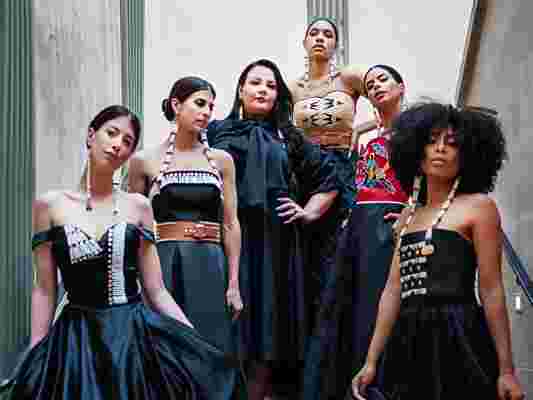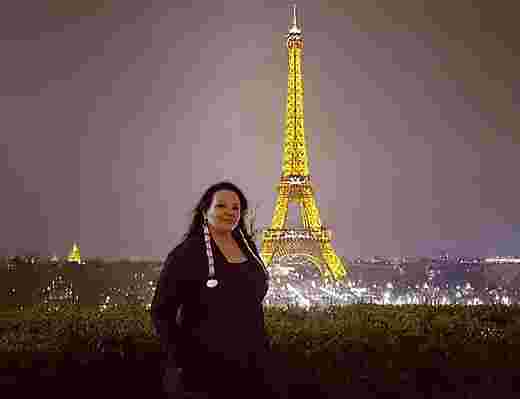
Norma Baker–Flying Horse shares what inspires her, who she designs for, and advice from her grandmother that has worked pretty well so far. Happy Women's History Month!
Thank you for giving the Smithsonian this interview. Please introduce yourself and tell us what tribe or Native nation you are affiliated with.
My name is Norma Baker–Flying Horse. I am Hidatsa, an enrolled member of the Mandan Hidatsa Arikara (MHA) Nation, as well as a member of the Dakota Sioux and Assiniboine tribes.
Do you have a Native name you can share?
My Native name is Red Berry Woman. My work is known as Red Berry Woman , after my Native name.
Where did you grow up, and where do you call home now?
I grew up in various places, including Alaska and Oklahoma, due to my stepfather being in the Army. The majority of my upbringing was spent between my father’s home reservation, the Crow Reservation, and my mother’s, the MHA Nation, where I currently live with my husband and five children.
How old were you when you became interested in fashion?
I would have to say about age six. I’d make my grandparents buy me the toy heels from Kmart, and we shopped secondhand stores, so I had a collection of used handbags, which I filled with rocks I found around the ranch. I somehow convinced my grandma to buy me a blazer and matching pencil skirt. With my toy heels and ’80s clutch, I was the most stylish six-year-old on the cattle ranch. Needless to say, fashion has always been a part of me. Affording it was another story.
Who has inspired you?
Chanel—not because she’s a label, but because she has an amazing story. I was drawn to her styles, and the more I learned of her history, the more I was inspired. She was orphaned, came from nothing, and with talent and drive she created a fashion empire that is still continuing long after her death.
Have you competed and won any awards for your work?
My work hasn’t been shown in any competitions. I entered it for Santa Fe but was turned down.
Do you consider your art form Indigenous popular culture?
I wouldn’t say pop culture, if that implies primarily for the young. I believe what I create can be done and should be done for all ages. Just as people in their golden age wear jingle dresses, the same as our tiny tots do, then my work should be aimed the same, to be for all.
How does your work reflect traditional Native art forms? When you’re asked by the fashion media to explain your work, how do you answer?
I use several of the same textiles on formal garments as I do in traditional outfits. Also smoked hides, beadwork, tribal designs, and traditional adornments like different types of shells.
My work aims to give balance and to show that Native people are still here. We were punished for being who we are, looking the way we do, dressing the way we do. A lot of our traditional clothing, we had to fight to keep. My work is a mixture of our cultural clothing and today’s modern clothing. We are finding ways to represent who we are while living in the modern world that was forced upon us.
A lot of non-Native people are interested in my work, and I find it hard to explain what my work represents simply. I create my work with the pride of my people and with my people in mind. I’m happy that non-Natives want to learn about our culture, not for the purpose of making it their own, but to try to understand us. I think we should all be open to learning about one another.
What is one of the biggest challenges you’ve faced in creating your fashion?
Trying to educate people who have attached a stigma to Native Americans.
What do you do to get inspired to be creative?
Finding inspiration has never been a problem. Our people are beautiful, and we have so much talent in so many artistic areas that I am constantly motivated and engaged in the creative process.
Are there any unique signature pieces that you’re known for?
I’m for sure known for the ledger-art ribbon skirts I create. Those are my most in-demand design.
How do your earlier pieces differ from what you produce today?
I don’t think I’ve changed what I do a whole lot. I think I may sew and cut a little straighter [laughter], but that may be about it.
Where are some notable places your fashions have been featured?
On the red carpet of the 2019 Grammys, where the reporter Corinne Oestreich wore gown with a ribbonwork bodice. On the 2018 Oscar stage, as well, where the young activist Alice Brownotter of the Standing Rock Nation wore one of my designs with dentalium shells during the performance by Andra Day and Common. My work has been worn on several notable fashion runways and at other events and powwows.

Can you tell us what it’s like to be a featured designer during Paris Fashion Week?
To be in Paris during Fashion Week was surreal, but to be a Native American designer showing for the Fashion Week Studio was amazing. I felt like a childhood dream had come true, and I was proud to represent my people.
Where do you envision the future of your fashion design headed on the world stage?
I don’t envision the future too much. I dream plenty, but I don’t envision. My Sioux grandmother use to tell me not to plan too far ahead, because those plans never work. I’m now an Oscar and Grammy red carpet designer, so she must have known what she was talking about. It’s been good advice so far.
Where can we find more of your work?
My social media outlets—Red Berry Woman on Instagram and Facebook are the best places to see my photos and videos of my work. Thank you.
Thank you. It's been a pleasure.
